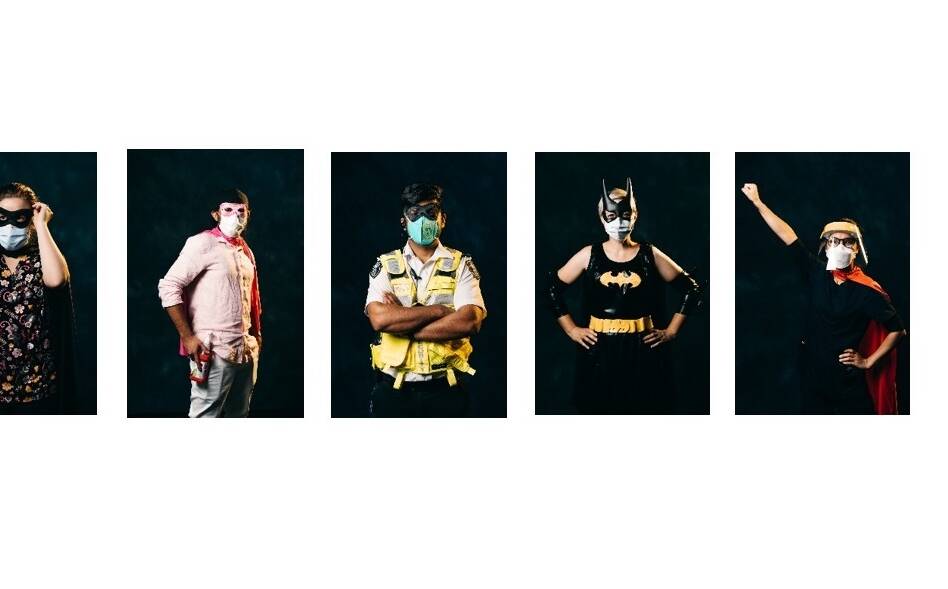
A series of artistic works - remarkably commissioned and completed during the height of the pandemic in Canberra - is about to go on exhibition, each one showing a unique aspect of the frontline health response to COVID in the national capital.
As testing and vaccinations centres were being set up in Canberra and health workers were, often, being plucked from their everyday job to be part of the frontline response to the pandemic, another effort was underway, behind the scenes, to capture the moment for posterity, in art.
The resulting exhibition, Stronger Together, Artists' perspectives on the COVID-19 frontline health response, was funded by Canberra Health Services and goes on display to the public from Saturday at the Canberra Museum and Gallery.
It includes everything from watercolours of Canberrans being tested for COVID to sound and video recordings of health workers in the midst of their task to photographs that elevate the medical routine of the workers to something enduring and artistic.
CMAG senior curator visual art Virginia Rigney said the artworks went beyond the countless news-of-the-day images and sound grabs that were captured during the pandemic and created something different and enduring.
"I feel like these images will feel really fresh to people because they're not the usual images we've seen around the pandemic," she said.
"But I think they'll also speak to people in 10, 20, 30, 40 years' time."
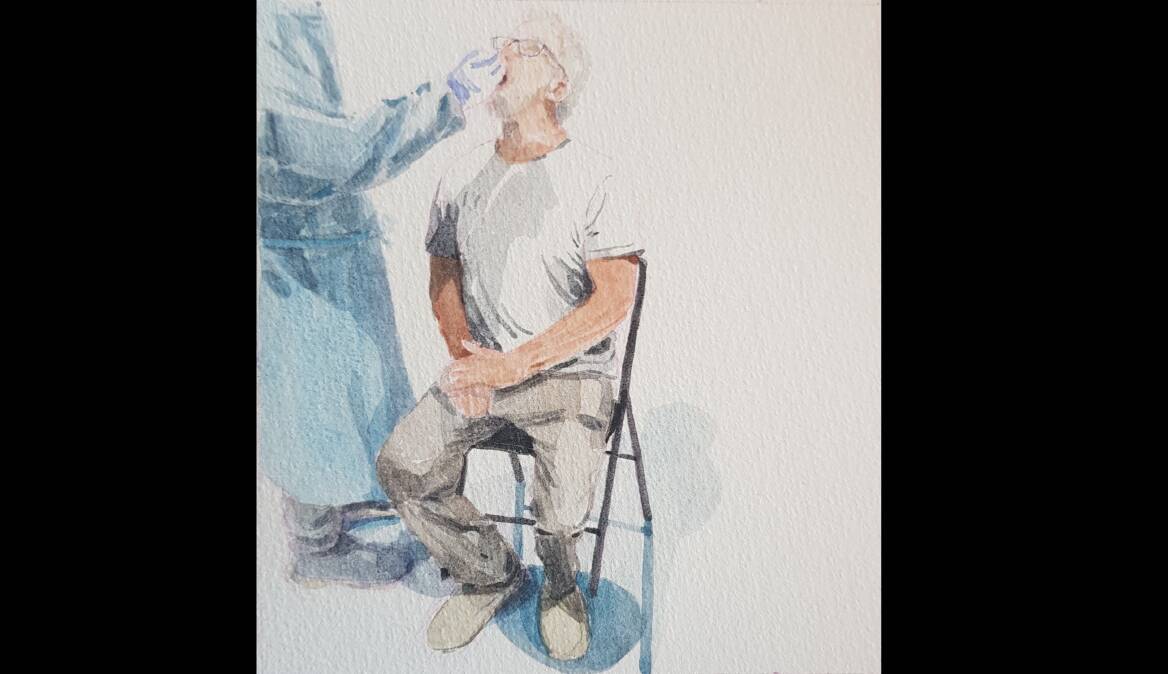
Canberra Health Services commissioned photographers Dion Georgopoulos and Marzena Wasikowska and watercolourist Waratah Lahy to capture the frontline health workers in the testing clinics and vaccinations centres.
A fourth artist, Ellis Hutch, joined the project via an ArtsACT grant and interviewed ACT Health directorate contract tracers, epidemiologists and others for a sound and video installation.
The project was driven by the Canberra Hospital's arts curator Jenny McFarlane, who helps to facilitate all the art in the hospital, and a government advisory committee that included Ms Rigney. And it was an endeavour in which everyone had to act quickly to capture what was unfolding in the pandemic.
"I flagged with the committee that this was a really historic moment for the overall Canberra community, but especially the healthcare workers. It was really their unseen work that was going to be quite profoundly affected," Ms Rigney said.
"Of course we were awash with images, of people lined up, this and that, but that was not really getting to the long-term potency of this experience.
"And I think artists are really well-equipped to be able to identify significant moments and to be able to bring their practice to them.
"We thought, for this, it couldn't be just be one person, it had to be multiple artists. And went with artists we were confident could deliver within the confines of this situation and who all had difference approaches."
The exhibition opens nearly three years after lockdowns started in Canberra and nearly two years after COVID vaccinations began to be dispensed in the ACT. It a reminder of those fraught early days of testing and vaccinations, complete with all the social distancing, the masking-up and the endless procedure that went with them.
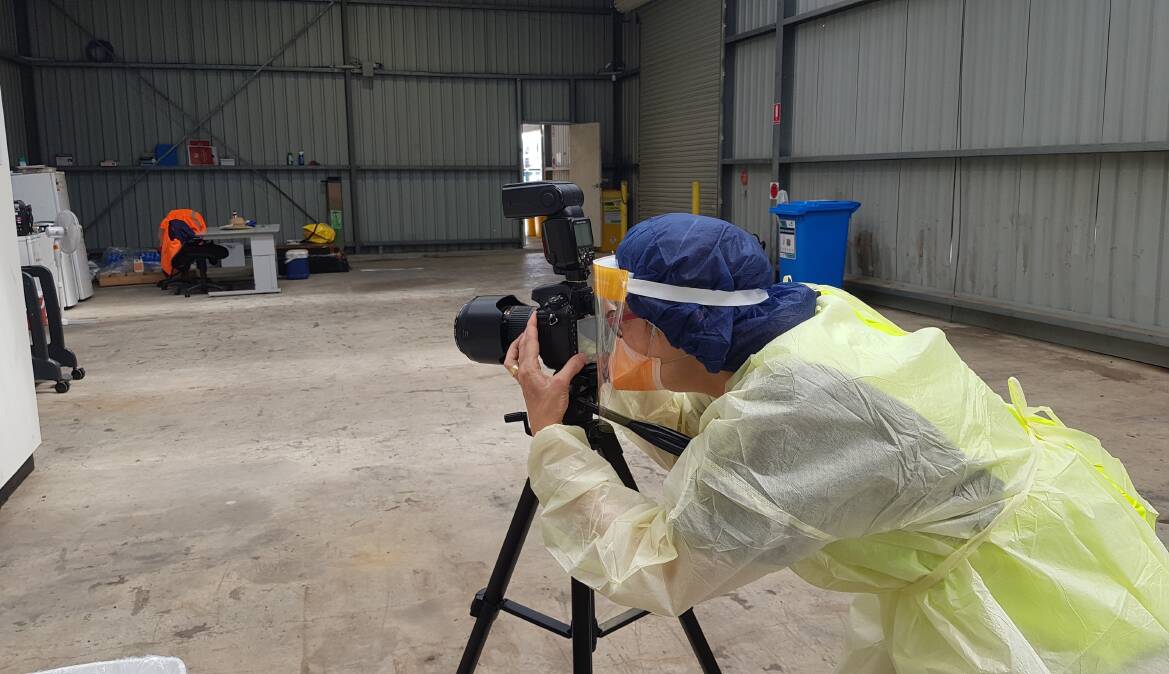
The artists, too, were kitted out in full PPE (personal protective equipment) as they captured images or sounds or impressions.
"Even wearing one of those plastic face shields and putting their face against the camera to focus, that, in itself, would have been tricky," Ms Rigney said.
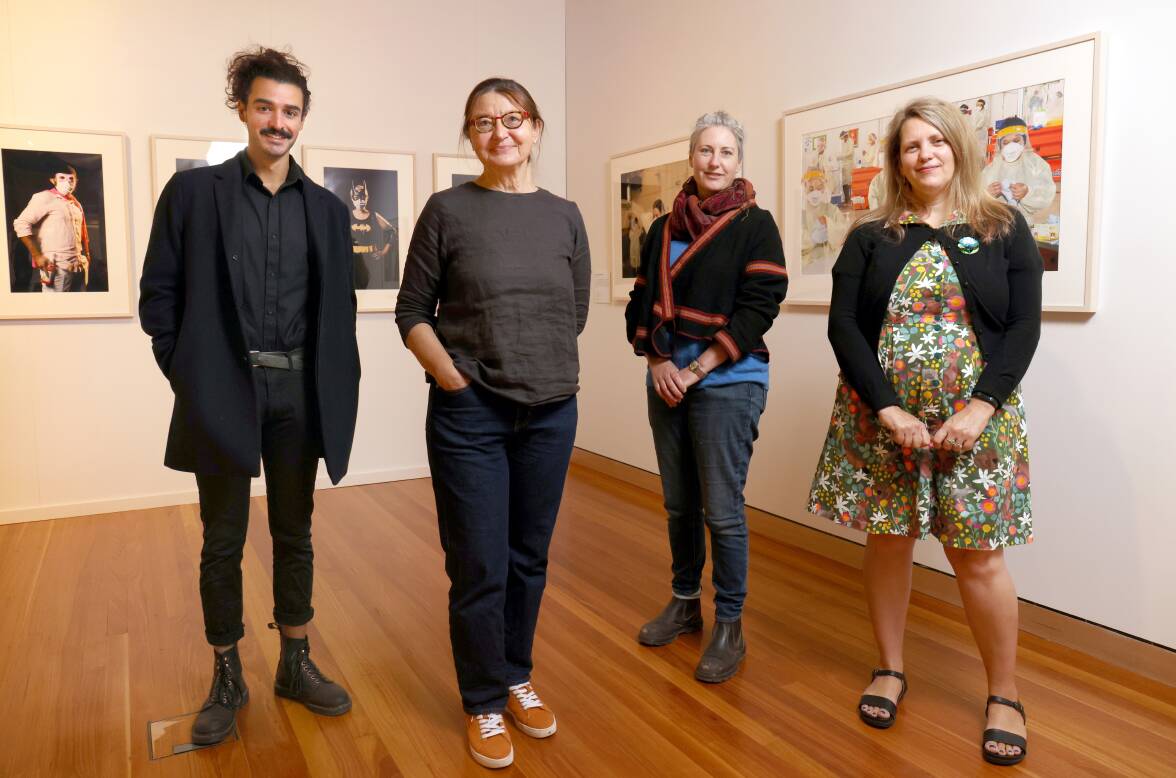
There also had to be the trust of the health bureaucracy who let the artists do their work in the midst of a pandemic. And there was the perennial issue of privacy, of protecting the workers and the public who were in the range of the artists and ensuring they were okay with being included in the project.
"We're so glad we went ahead and did this even though it was awkward," Ms Rigney said.
"Credit to Jenny for pulling it together, credit to the committee for going, 'Yep, let's do this' and credit to the big powers-that-be at Canberra Health Services who went, 'Yep, we'll leave ourselves open to this'.
"They let artists in to do their own thing without being told what they do. What the legacy, and what the result of that is, is you've got images that speak to not just now, but into the future."
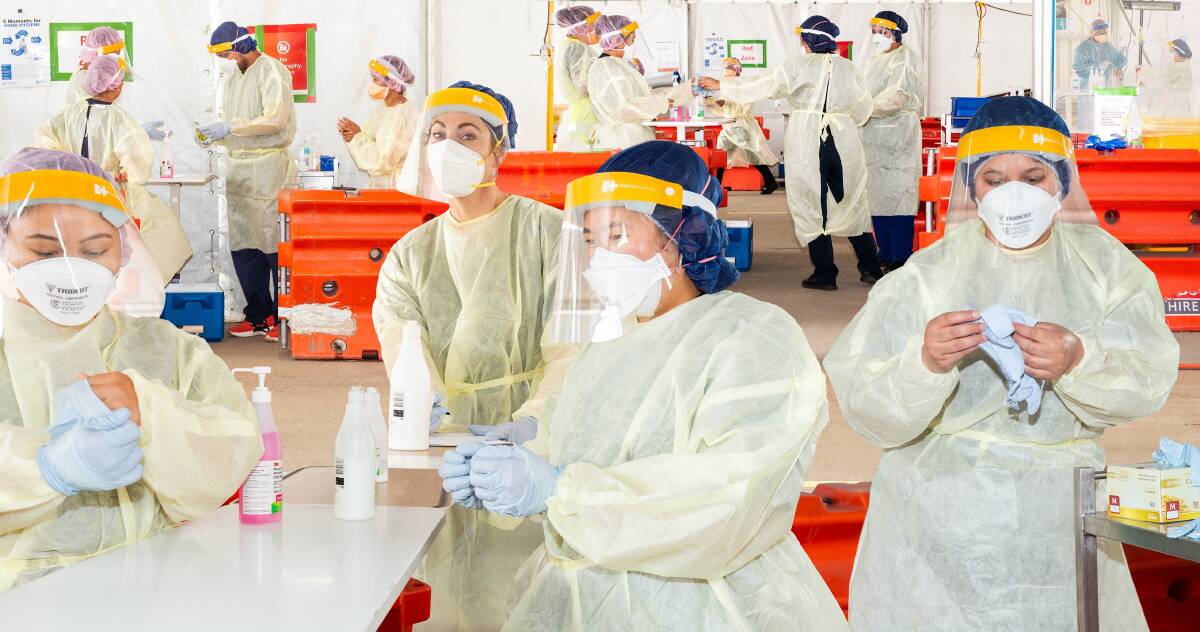
And the works are evocative.
Waratah Lahy's series of watercolour and pencil works, called Waiting, highlights the little, often overlooked, details of the health response - an empty chair waiting to be filled at the AIS vaccination centre, a gloved hand picking out vial, a security guard standing in the shade at the drive-through testing centre at the Exhibition Park in Canberra.
Ms Rigney said they were "throwaway moments" captured in exquisite detail. And the artist saw details in everything.
Ms Lahy remembered visiting the AIS vaccination centre on a day when the sky was brilliant blue and "there was a sense of the surreal; the intensity of the high-vis vests in such open spaces".
"The AIS felt like a theatre set with its black curtaining and pops of repeat colour, and everyone was doing their part working together against this dramatic backdrop," she said.
Dion Georgopoulos, a former photographer with The Canberra Times, was in the right place at the right time. His idea was to do portraits of health care workers and was inspired when many of them dressed in super hero costumes at the AIS vaccination centre on the first day children were being vaccinated.
"It made so much sense, that the health workers should be portrayed as super heroes because the health workers were the ones place on the frontline of this whole pandemic," he said.
"They're all masked, no one knows who they are and they're putting themselves second to the community's needs.
"And when I saw that I thought, 'That's the definition of a superhero - no one knows who they are and they're helping selflessly in the community'."
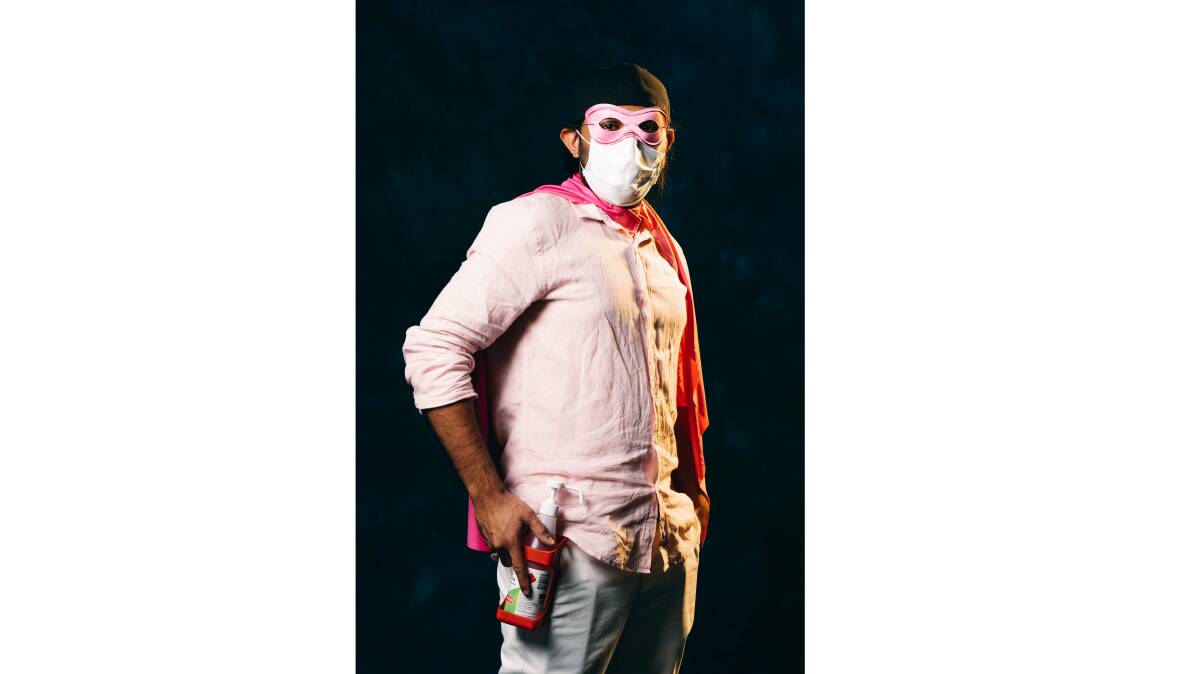
One of the workers Georgopoulos photographed was Haider Rana who usually worked in administration for Canberra Health Services but during the pandemic was seconded to work at the Garran and AIS centres, helping to log people for testing and vaccinations.
He had joined Canberra Health Services at the height of the COVID-19 response after losing his job interstate in customer service as a result of the pandemic.
It was almost a calling to join the health workforce.
"At the time, the COVID response was the most important job in the world and I was lucky to be part of this team who worked on Canberra becoming the most vaccinated city in the world," he said.
Mr Rana, 28, made his own super hero costume - Hand Sanitiser Man - for Super Hero Saturday at the AIS, evoking the bottles of pink hand sanitiser seen all over health centres and hospitals, not just during the pandemic.
"The character became so popular that everywhere I went people were asking for photos, they were putting out their hands to get sanitiser," he said.
"It was an original creation that came into existence because of the needs of the time and isn't that exactly how every super hero is born?
"I was so glad that Dion was there at the right time to capture that moment with his lens and that it became part of this art exhibition. I caught a glimpse of it and it was beautiful and I really can't wait for the community to see it as well."
Ms Rigney said the super hero portraits showed another more positive side of the pandemic.
"I think it is such a special group of works because of all that was going on. The workers were prepared to have a sense of humour and support children who were going to be quite anxious," she said.
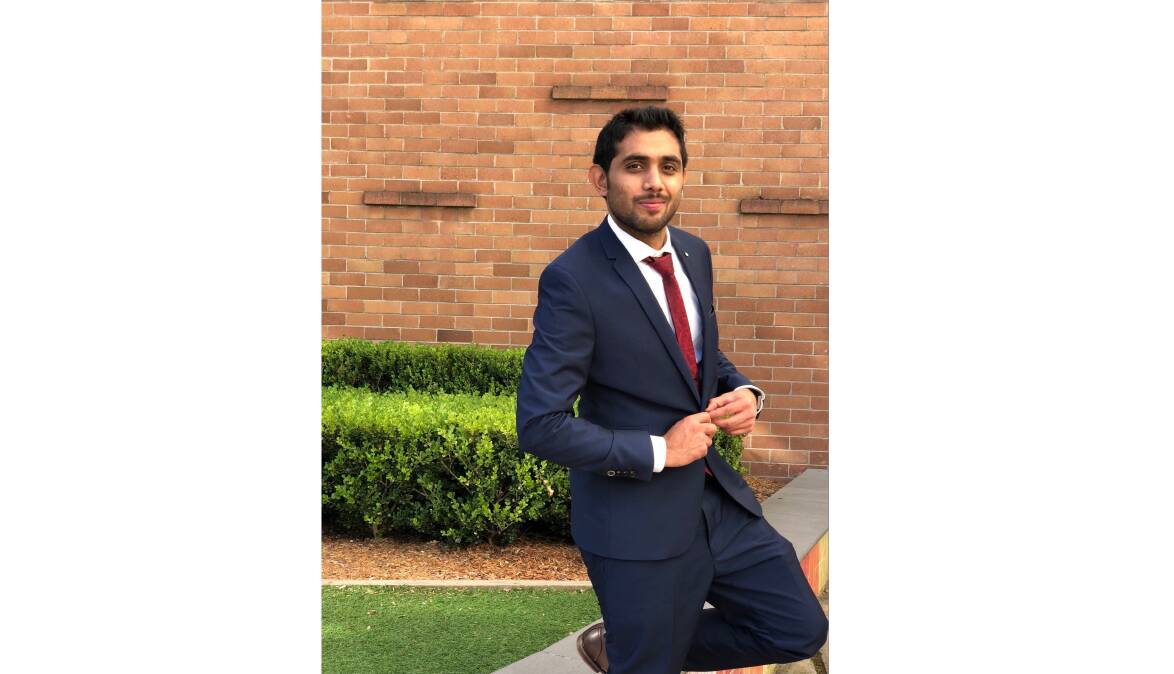
Photographer Marzena Wasikowska adds another dimension to the Stronger Together exhibition, almost literally.
She took hundreds of photographs of heath workers at sites such as the Mitchel and EPIC testing clinics or AIS vaccination centre as they performed test after test or preparing a vaccine and layered the images to create work that has an otherworldly quality to it.
"I was so impressed with the incredible focus required for this work and the synchronised efficiency on the floor," Ms Wasikowska said.
"The careful gestures and movements made me think of a beautifully choreographed ballet."
Ms Rigney says that teamwork and coordination was captured in Ms Wasikowska's images and taken it further.
"She has also transformed what was quite a repetitive prosaic work practice into something that's got this extraordinary grace to it," she said.
And then there are the conversations and observations of the pandemic that artist Ellis Hutch recorded.
Ms Rigney said Hutch interviewed more than 40 workers, mostly in person.
"And really recorded them how they felt in the moment. Again, this is not commentary you would hear in a news grab, they're actually how people were feeling day to day," Ms Rigney said.
The curator believes in the exhibition, "all four bodies of work really talk to each other but are all still quite different". They remind everyone of a major moment in history.
"As much as many people do want to put it behind them and not think about it, I think CMAG very much wanted to partner with Canberra Health Services and celebrate these people who have kept us safe," she said.
* Stronger Together, Artists' perspectives on the COVID-19 frontline health response opens to the public on Saturday at the Canberra Museum and Gallery in Civic Square off London Circuit. The exhibition continues until July 30.







